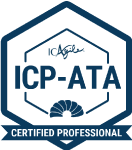Overview
High performing organizations use automated testing to achieve greater productivity and reliability. Every change and new feature are instantly checked to see if it meets intended requirements and doesn’t break the rest of your systems.
Today every software team faces the challenges of delivering more capabilities on faster timelines with greater reliability. In this test automation training course, you will learn how to improve your development throughout and reliability by replacing slow, boring, and error-prone manual testing with fast, repeatable automated tests. Organize your systems and processes to get the most out of automated testing. Improve system reliability by improving test coverage. Support deployments across many platforms with a single set of reusable tests.
Successfully completing this course makes attendees eligible for the ICAgile Certified Professional in Agile Test Automation (ICP-ATA) Certification.

Successfully complete an ICAgile accredited course taught by an ICAgile Authorized Instructor.
ICAgile Authorized Instructors can withhold certifications based on lack of participation or understanding of course learning outcomes.
GSA: $1485 USD
16 PDUs
Next Upcoming Course


Train up your teams with private group training
Have a group of 5 or more students? Cprime also provides specialist private training with exclusive discounts for tailored, high-impact learning.
Test Automation Boot Camp (ICP-ATA) Schedule
Full Course Details
Part 1: Introducing Test Automation
- Watch an Automated Test
- Requirements
- Exercise: Identify different requirement types
- Exercise: Make requirements testable
- Testing Types
- Black-box vs. white-box
- System testing vs. integration testing vs. unit testing vs. acceptance testing
- Application Types
- Process-driven or data-driven: no "one size fits all"
- Exercise: Define different kinds of tests for different application types
- The Alphabet Soup of Tools and Methods
- Selenium. Gherkin. Cucumber. HPQC. Jira—you hear all of these. What do they mean? How do they fit together? Which do you need and which can you safely ignore?
- Exercise: Testing facts and fallacies
Part 2: Preparing for Test Automation
- Effective Partitioning Schemes
- Exercise: Structure a system into processes (actor goals), activities, actions
- Use Cases and Test Cases
- Exercise: Create a test case for a single activity from a written use case (happy path)
- Behavior-Driven Languages
- Exercise: Write a test case as a Gherkin scenario
- Modeling and Diagramming Techniques
- Exercise: Construct a UI navigation map for normal and alternate flows
- Equivalence Partitioning and Boundary Value Analysis
- Exercise: Define input value choices and use TAME to construct test alternatives
Part 3: Recording Automated Tests
- Automated Test Steps:
- Pre-checks, Inputs, Events, and Post-Checks
- Exercise: Write the steps of an automated test
- Record and playback a single test
- Exercise: Record and play back a test in Selenium WebDriver
Part 4: Dissecting Automated Tests
- Recorded Test Steps
- Exercise: Examine recorded steps in Selenium
- UI Element Repositories
- Exercise: Examine the components of a UI page
- Exercise: Create path expressions to locate page elements
Part 5: Assembling Automated Tests from Modules
- Test Suites, Test Cases, and Modules
- Exercise: Partition a recorded test into reusable modules
- Modular Test Development
- Exercise: Construct test cases from existing modules
- Exercise: Construct new modules for alternate behaviors
Part 6: Coding Automated Tests
- Code always, Code sometimes, or Code never
- The Skills Pyramid
- Open-source and commercial tools
- Exercise: Compare tools and team capabilities
Part 7: Exploiting Automated Testing
- Test-driven development: test cases as specifications
- Data-driven tests
- Exercise: Define data tables for equivalence partitions and boundary value analysis
- Multi-platform and cross-browser testing
- Exercise: Run test cases on multiple web browsers
Part 8: Enabling Continuous Integration with Test Automation
- Regression test suites
- Development events trigger test runs
- Configure test subsets
- Exercise: Define a minimal "smoke test" and contrast with a full regression suite
- Report test results
- Exercise: Design a dashboard for quick reporting of test results
Part 9: Course Summary
- Quiz: Testing facts and fallacies
- Exercise: Plan your own test automation strategy
This course is tool agnostic, but you will do a review of the options available to you in the market.
Professionals who may benefit include:
- Software Developers and Programmers
- Business Analysts
- Quality Assurance Professionals
- Software Testers
- Product Owners
- Project Managers
- IT Managers
- Software Engineers
- Identify different requirement types
- Define different tests for different application types
- Review the various tools and methods available for test automation
- Write a test case as a Gherkin scenario
- Construct modeling and diagramming techniques
- Write the steps of an automated test
- Record and playback a test in Selenium WebDriven
- Partition a recorded test case into reusable modules
- Exploit automated testing for data-driven, multi-platform and cross-browser testing
- Use test automation for implementing continuous integration
Although there is not an ICAgile official exam, ICAgile allows for their course accreditors to determine appropriate means for retention of the learning outcomes. Depending on your provider, there may be some type of assessment in order to earn certification.
Many providers assess via participation, activity and understanding conveyed via exercises and discussion, withholding certification when appropriate.
